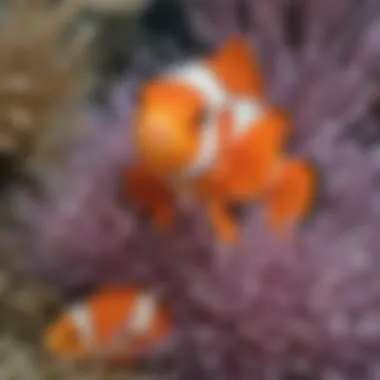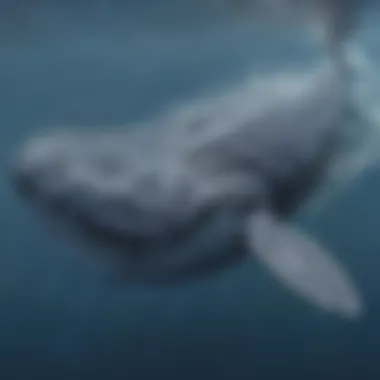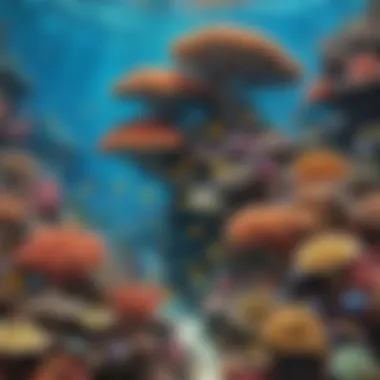Exploring Sea Animals: A Visual Guide to Marine Life


Intro
The ocean is a vast and mysterious world. It has enourmous variety of animals and plants. These sea creatures are not only beautiful but also play important roles in our ecosystem. Through this visual guide, we will delve deeper into their lives, offering insights into their habits and the environments they thrive in. This journey aims to bring awareness and appreciation, especially to younger audiences eager to learn about marine life.
Science Fun Facts
Marine life is filled with surprising details that can fascinate everyone. Here are some fun and interesting facts:
- Did you know that octopuses have three hearts? Two pump blood to the gills, while the third pumps it to the rest of the body.
- The blue whale is the largest animal on Earth. It can weigh as much as 33 elephants!
- Sea turtles can live for more than 100 years. They navigate using the Earth's magnetic field.
Explore the diverse marine life that exists in every ocean around the globe.
Interesting Trivia and Facts
Many individuals are passionate about marine biology. They study animal behaviors and relationships within their ocean habitats. For example:
- Some jellyfish are 95% water.
- The clownfish can adjust to the anemones, which are significantly dangerous for other fish.
- Pufferfish can inflate their bodies to deter predators.
Quirky Science Stories
There is always somthing new to learn in the ocean. Many scientific adventures tell incredible tales. One such story involves the discovery of deep sea creatures in 2008. A team of explorers used advanced camera technology to unveil creatures like giant squid that were previously thought to be myth.
Amazing Science Records
In attending to sea life reports, remarkable records have been noted:
- The fastest swimming fish is the black marlin, which can reach speeds up to 82 miles per hour.
- The largest fish in the sea is the whale shark, which can grow up to 40 feet long.
Thought-Provoking Questions
As we learn more about marine animals, it’s important to ask questions:
- How does pollution affect marine life?
- Why are certain species crucial for the health of the ocean?
- In what ways can we help protect the habitats of these creatures?
Discover the Wonders of Science
Understanding marine life encourages curiosity. Here, we will discuss various scientific concepts related to sea animals. Educational videos and animations highlight aspects of marine environment. Engaging tools help reinforce learning:
- Apps that promote interactive exploration of ocean ecosystems
- Documentaries showcasing marine biology in action
Additionally, recognizing real-life applications of science helps ground these lessons. Ocean preservation efforts relate directly to our everyday lives and the importance of environmental stewardship.
Science Quiz Time
Testing knowledge is vital for learning.
Interactive Quizzes
Quizes can help us digest information:
- What is the largest shark species?
- Which mammal lives in the ocean?
These types of questions can bridge the gap to engaging and fun well with learning.
Learning Through Gamification
Utilizing games can enhance educational experiences. By incorporating fun challenges related to marine biology, learners retain information more effectively.


Science Experiment Showcase
Creating hands-on experiences makes marine science relatable. Experimentation is exciting. Here, we provide fun activities:
Fun and Engaging Experiments
- Water Density Rainbow: Create layers of different liquid densities using sugar. This shows different ocean layers!
- Salt Water Fish Tank: Utilize small containers to set up fish habitats using rocks, sand, and plants while discussing nutrients.
Safety Tips and Precautions
When conducting these experiments, safety is paramount. Always handle materials cautiously and ensure space is clean and supervised.
Through these explorations, excitement for learning about sea animals will engender. Each moment spent examining the ocean can open up profound insights into our planet's vital ecosystems.
Prolusion to Sea Animals
Studying sea animals is crucial for several reasons. First, it helps us understand the delicate balance of marine ecosystems. Sea animals play a significant role in maintaining biodiversity, which is essential for the health of our planet. With so many species relying on each other for survival, learning about these animals creates awareness about their environment and the challenges they face.
The ocean is home to nearly 230,000 different identified marine species, with countless more yet to be discovered.
Second, knowledge of marine life contributes to education. Elementary school children benefit from engaging with vibrant ocean themes. Young learners can enhance their interest in science through visual guides that depict the beauty of life beneath the waves. This interactive website resource can assist both parents and teachers in conveying complex concepts, such as adaptations and ecosystems.
The ocean holds more than just incredible creatures. Each marine animal, whether big or small, has characteristics that support its ecosystem. From the tiniest plankton to colossal whales, their interactions reveal fascinating behaviors and survival strategies. By investigating these remarkable sea animals, we can promote environmental stewardship. This lays a foundation for future generations to utilize healthy practices that protect our oceans.
Moreover, discussing the importance of studying marine life helps confront various pressing issues that endanger these environments, like climate change and pollution. Raising awareness about the challenges facing sea animals is critical in inspiring action. Through conservation efforts, such knowledge can guide human behavior toward sustainable practices that support marine life.
In essence, understanding sea animals aligns with essential educational tools. It offers methods to grasp ecological complexities, highlights significant environmental challenges, and fosters consumer awareness to preserve our oceans.
Importance of Studying Marine Life
Studying marine life offers insights into unique adaptations that various species exhibit to thrive in diverse underwater environments. For example, fish have evolved with different fins and body shapes to aid swimming efficiently in water currents. In addition, understanding behavior is central to studying marine organisms. These animals display diverse techniques for communication and survival.
Moreover, science demonstrates that various sea creatures blend critical ecological roles in food chains. Unraveling these complex interactions illuminates how energy flows through ocean systems and reflects the impact of habitat loss on sea populations.
Traversing marine studies enables budding scientists and young explorers to grasp the principles of marine biology, showcasing the interconnectedness of life. Studying marine life passionately seeks uninformed policy decisions, inspiring responsible actions positively influencing marine environments.
Diversity of Ocean Ecosystems
The ocean consists of distinct ecosystems, like coral reefs, open oceans, and deep-sea areas, each boasting unique features and species. Exploring ocean biodiversity not only increases our appreciation for nature but catalyzes a better grasp of ecosystems' contributions to overallcommunity health justice. By classifying ecosystems, individuals can understand their respective roles in climate regulation and habitat stability.
Here are key types of marine ecosystems:
- Coral Reefs: Diverse habitats that support numerous species.
- Open Ocean: Many species, including fish, seabirds, and even dolphins, feed and thrive.
- Deep Sea: Home to unique organisms, like the anglerfish and giant squids, often adapting to extreme conditions.
In summary, marine biodiversity fosters exploration and sparks curiosity, drawing learners into integrating marine sciences. Such understanding allows natural enthusiasts to become confident advocates for the ocean. From science classrooms to playful beach outings, the study of sea animals extends into various environments, unearthing nature for future encounters.
Types of Sea Animals
Understanding types of sea animals is essential for appreciating marine biodiversity. Each category represents a diverse group that contributes to oceanic systems. Recognizing these differences helps foster a deeper awareness of how species interact within their habitats. Learning about various sea animals allows young minds to engage with the knowledge of ecosystems.
Invertebrates
Characteristics of Invertebrates
Invertebrates form a vast group of animals without a backbone. This unique aspect adds to their diversity in forms and habitats. They often exhibit traits like adaptability, incredible reproductive strategies, and resistance to harsh conditions. These qualities make them a common focus in introductory marine studies. Different invertebrates perform significant roles in the ocean, be it as primary consumers or integral parts of the food web. Some enter marine research because their features offer useful insights into environmental health.
Examples of Sea Invertebrates
Examples of sea invertebrates include jellyfish, starfish, and octopuses. Each has distinct characteristics that showcase the diversity of this group. For instance, jellyfish can display mesmerizing bioluminescence, which plays a role in predation and defense. This dazzling feature adds to their charm in educational contexts. Other popular examples, such as the octopus, intrigue many due to intelligence and problem-solving abilities. Each type draws interest but also highlights the specialized adaptations these animals have evolved over time.


Fish
Diversity among Fish Species
Fish species showcase extensive diversity worldwide, from tropical waters to polar regions. This varying range is vital for understanding marine biology. Fish adapt to several environments, offering ideal studies into evolutionary biology. Factors such as climate change or habitat destruction make exploring these differences all the more interesting. Prominent characteristics of fish include body shape, size, and coloration, that let them rapidly adapt to different aquatic environments.
Adaptations of Fish
Adaptations among fish are notable and include morphological and behavioral aspects. The types of adaptations can be found in skin color, body shape, muscle structures, and breeding habits. For example, some fishes have developed specialized fins, enabling them to evade predators effectively. Recognizing these adaptations could broaden comprehension of natural selection's role in a changing world. Understanding these mechanisms highlights the resilience needed for survival in a fluctuating marine environment.
Marine Mammals
Behavior and Adaptations of Marine Mammals
Marine mammals demonstrate profound behaviors reflecting their intelligent nature. Adaptation plays a vital role in behaviors like communication, social structures, and caring for their young. For example, dolphin social groups help convey strong social bonds and cooperative hunting. Emphasizing these behaviors is beneficial for their complexity in social dynamics. Readers can find mammal behaviors are both fascinating and approachable educationally.
Examples of Marine Mammals
Examples of marine mammals include whales, dolphins, and seals. Each of these species showcases distinctive attributes. The humpback whale’s migratory patterns or killer whales' sophisticated hunting styles demonstrates behavioral adaptability against environmental changes. Such unique features offer compelling avenues for exploration and discovery by younger audiences. Recognizing different communities deepens knowledge about ocean life.
Reptiles
Characteristics of Marine Reptiles
Marine reptiles, such as sea turtles, possess unique characteristics like specialized limbs for swimming and the capability to hold breath underwater. These features underline their evolutionary pressure. As they glide through water, they maintain the connection required for life above and below the surface. Effectively learning their importance highlights the deep interdependence present among marine species.
Examples of Marine Reptiles
Existences largely recognized include the green sea turtle and saltwater crocodile. Their distinct physical features enable study on adaptations, shaping their way of life wonderfully. A sea turtle's hard shell provides protection against predators and physical threats, while the male saltwater crocodile’s pursuit behavior emphasizes strong territorial instincts. Each offers an opportunity for learning about unique ecological adaptions in marine environments.
Birds
Coastal Bird Species
Coastal bird species often represent diverse ecological roles necessary for healthy seaside ecosystems. Species like pelicans display fascinating behaviors in hunting and nesting resulting in exclusivity worth studying. Many coastal birds participate in controlling fish populations and maintaining healthy tides. Each plays a formidable part in the balance between marine life and its overarching elements.
Role of Birds in Ocean Ecosystems
The broader role of birds influences pollutoin, accentuating what makes ocean louer important. By illustrating strong connections to their environment acomplishes two points. As birds serve as indicators of ecologicla measeures, their nosaheri signifies more general health in an ecosystem. Encouraging the สล็อตของข้อมูลху limnić khí carbon fueling facultative helps relate strategy for long-loving attraction.
Key Habitats
The study of sea animals often hinges on understanding their habitats. Different sea animals live in diverse locations, each contributing uniquely to the overall marine ecosystem. Recognizing these habitats helps to appreciate the intricate relationships among marine life, guiding us further into marine conservation efforts.
Coral Reefs
Importance of Coral Reefs
Coral reefs act as vital ecosystems within our oceans. They support a wide variety of marine species, providing shelter, food, and breeding grounds. The rich biodiversity present in coral reefs significantly contributes to the health of ocean ecosystems. These habitats are considered important indicators of environmental health; if coral reefs flourish, it generally indicates clean, unpolluted waters. However, they are delicate structures, susceptible to climate change and human-induced damage, making their conservation crucial.
Species Found in Coral Reefs
Coral reefs house an impressive variety of species. Fish, invertebrates, and other marine animals call this habitat home. Among the notable inhabitants are clownfish, sea turtles, and various species of coral itself. The unique complex structure of coral reefs offers niches for countless organisms, creating a vibrant living tapestry. This biodiversity seems to bring population resilience, making such ecosystems vital for both marine environments and human dependency.
Deep Sea
Ecology of the Deep Sea
The deep sea presents a vastly understudied area of marine biology. It consists of regions that are more than 200 meters below the ocean's surface, characterized by extreme conditions such as high pressure and low temperatures. In this habitat, unique ecological dynamics thrive, revealing essential details about marine life that survive in darkness. Organisms here often rely on chemosynthesis, rather than photosynthesis, for energy. The items along the deep-sea floor, like hydrothermal vents, create unique ecosystems that profoundly impact the global climate.


Unique Adaptations of Deep-Sea Creatures
Creatures in the deep sea showcase remarkable adaptations. For example, the angler fish uses bioluminescent lures to attract prey, while other species have developed incredible stretchable bodies to survive extreme pressures. These adaptations highlight the resilience of life in unforgiving environments. Moreover, studying deep-sea inhabitants can yield valuable insights into evolutionary processes and potential biomedical applications.
Coastal Regions
Life in Tidal Zones
Tidal zones represent fascinating landscapes where land meets sea. These areas are constantly changing due to rising and falling tides, creating dynamic habitats. They support species like crabs, starfish, and various mollusks, proving crucial for life cycles. The ability of the animals to adapt to such environmental fluctuations demonstrates their resilience and highlights the importance of tidal zones in overall ocean health.
Threats to Coastal Ecosystems
Despite their abundance of life, coastal ecosystems face numerous threats. Pollution, overdevelopment, and climate change fundamentally disturb delicate habitats. These issues pose risks to the biodiversity that exists in coastal areas. Containing runoff pollution and establishing protective measures remain necessary steps to mitigate these risks and safeguard the myriad species relying on coastal ecosystems for survival.
Open Ocean
Characteristics of the Open Ocean
The open ocean, often perceived as desolate, is densely populated with life. It extends beyond the continental shelf, covering most of the Earth’s surface. Its currents provide a pathway for various adaptations among marine species. While it's a more homogenous habitat, it plays a vital role in regulating the planet's climate and serves as a migration pathway for numerous species, including whales and sharks.
Species Found in the Open Ocean
Numerous species flourish in the open ocean. Tuna, swordfish, and large marine mammals traverse freely on the expansive seas. Each species has adapted uniquely to the challenges their environment presents. Many have streamlined bodies that facilitate swift movement through water. Furthermore, many of these animals migrate over massive distances, playing an essential part in marine food chains and supporting ecological balance.
Understanding these key habitats and the creatures inhabiting them is pivotal in our quest for marine conservation. Armoring ecological knowledge empowers us to protect our oceans effectively.
Conservation of Marine Life
Conservation of marine life is vital for preserving the biodiversity of our oceans. Sea animals play crucial roles in maintaining healthy ecosystems. Their presence can offer sign of the overall health of marine environments. A strong focus on conservation can help mitigate the threats these animals face and promote sustainable practices. Protecting marine life means safeguarding the services they provide to humans, such as food, tourism, and climate regulation.
Threats Facing Sea Animals
Pollution
Pollution is a significant challenge facing marine life today. It encompasses various types of contaminants, including plastics, chemicals, and oil spills. The key characteristic of pollution is that it disperses rapidly through the ocean, affecting vast areas. Addressing pollution is crucial because contaminants can cause dire health issues in well-defined marine species.
A unique feature of pollution is its widespread impact. Some pollutants settle in the ocean floor, where certain sea creatures can ingest them over time. These events replicate towards significant disadvantages, not only affecting the targeted species but cascading through the entire marine food web. The need to reduce pollution is not often prioritized, yet it poses grave threats to marine ecosystems.
Overfishing
Overfishing is another urgent problem faced by many coastal and oceanic regions. Practically, this practice leads to population declines for targeted fish species. The key characteristic of overfishing is that it disrupts the natural population dynamics. Such practices deeply harm the marine ecosystem and thereby diminish fish stock levels.
The unique aspect of overfishing is how quickly fish populations may collapse if no measures are taken. Sustained overfishing has reduced stocks of many species, posing both ecological and economic threats. Understanding and addressing the risks of overfishing is crucial for the sustainable management of fishery resources. As a result, ensuring responsible fishing practices can significantly aid marine conservation efforts.
Conservation Efforts
Protected Marine Areas
Protected marine areas are essential for fostering marine biodiversity. These zones restrict harmful activities such as mining, oil drilling, or commercial fishing. The key trait of protected marine areas is that they promote habitat restoration and provide refuge for stressed species. Notably, these areas are popular tools in conservation as they allow marine life to recover and thrive.
Community Involvement in Conservation
Community involvement in conservation represents a vital connection where citizens lead local efforts. The aspect relates closely to education and activism, where engaged communities can proactively safeguard their marine environments. The key trait is that grassroot efforts can foster environments of responsible stewardship towards marine ecosystems.
This involvement has the advantage of enhancing public awareness about marine conservation. When local communities feel empowered, they better participate in sustainable practices. More informed citizens contribute to meaningful and impactful protective measures for the oceans they rely upon.
Community engagement is not only about improving ecosystems but also building stronger societal ties with nature.
Through conscientious action, combined with policy applications, it is possible to keep oceans thriving for future generations.
Finale
The Importance of Awareness
Awareness about marine life is crucial for several reasons. First, understanding the diversity of sea animals promotes appreciation among young learners. Educators and caregivers can facilitate discussions about how these animals live and thrive in their unique environments. This enhances children's knowledge, fostering curiosity about nature. Second, by becoming aware of threatened species, children can understand the impact of human actions on marine ecosystems. Awareness leads to advocacy, encouraging young age of life to participate in conservation efforts.







